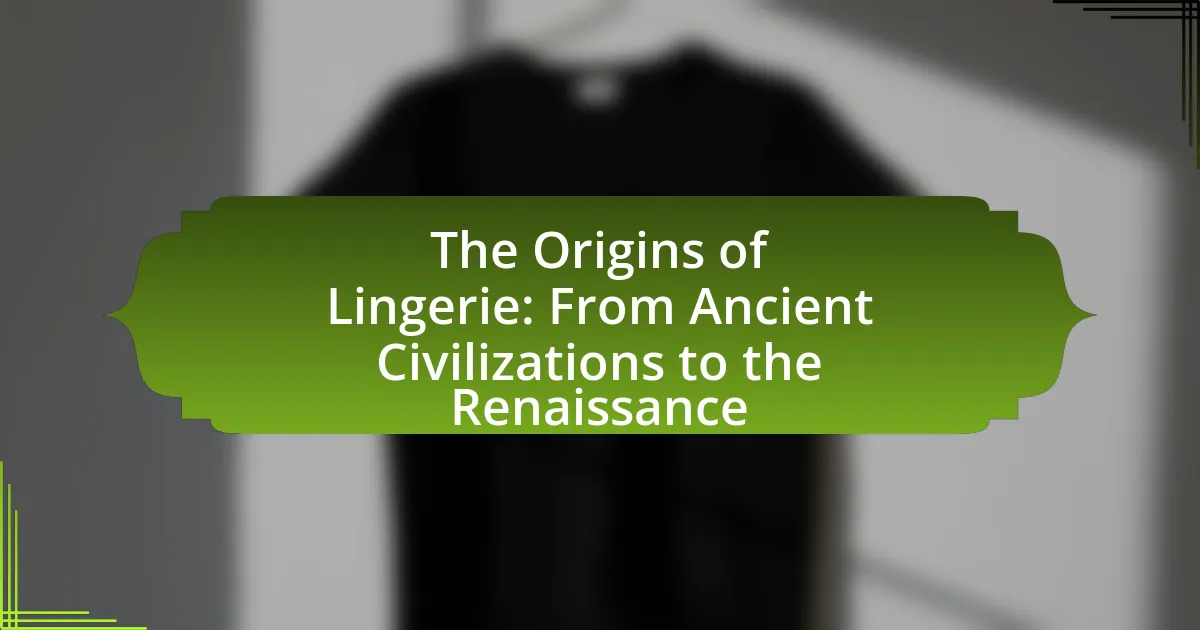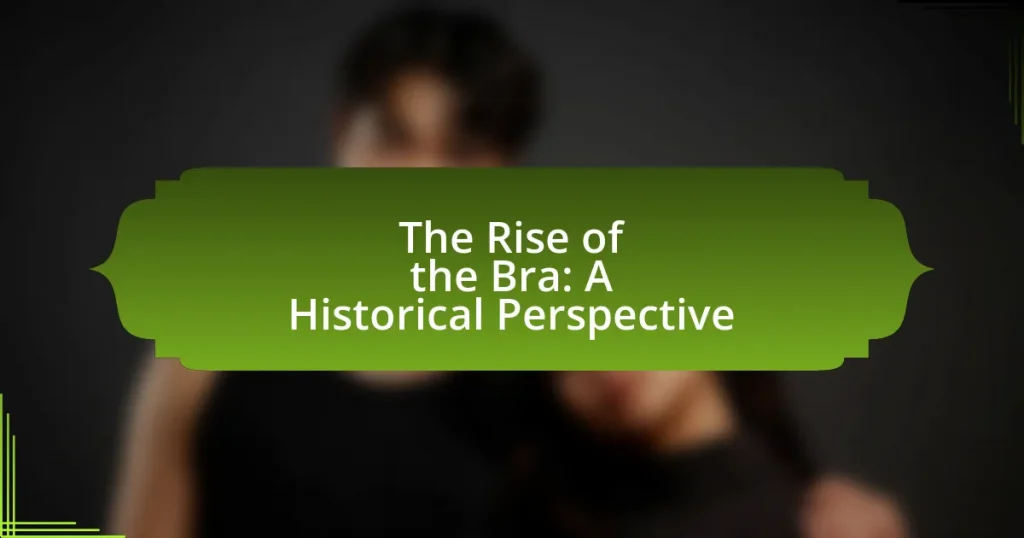The article explores the historical roots of lingerie, tracing its evolution from ancient civilizations to the Renaissance. It examines the types of undergarments worn in ancient Egypt, Greece, and Rome, highlighting how societal norms and cultural values influenced their design and function. The discussion includes the emergence of structured garments like corsets during the Middle Ages, the impact of social status on lingerie choices, and the innovations in materials and techniques during the Renaissance. Additionally, the article reflects on how historical trends inform contemporary lingerie designs and the implications of these developments on modern fashion.

What are the Historical Roots of Lingerie?
The historical roots of lingerie trace back to ancient civilizations, where garments designed for support and modesty emerged. In ancient Egypt, women wore simple linen undergarments, while in ancient Greece, the strophium, a band of cloth, served to support the breasts. The Roman Empire saw the introduction of the strophium and the subligaculum, which were early forms of undergarments. During the Middle Ages, the corset began to take shape, evolving from earlier supportive garments, and by the Renaissance, lingerie became more structured, with the introduction of the bodice and chemise, reflecting changing fashion and societal norms. These developments illustrate the continuous evolution of lingerie from functional undergarments to more intricate designs influenced by cultural shifts.
How did ancient civilizations influence the development of lingerie?
Ancient civilizations significantly influenced the development of lingerie through their clothing practices and cultural norms surrounding modesty and femininity. For instance, in ancient Egypt, women wore a simple linen garment called a kalasiris, which served both functional and aesthetic purposes, laying the groundwork for later undergarments. Similarly, in ancient Greece, the strophion, a band of cloth worn to support the breasts, exemplified early forms of lingerie that prioritized comfort and support. These garments reflected societal values regarding women’s bodies and modesty, which continued to evolve through subsequent civilizations, ultimately shaping modern lingerie designs.
What types of undergarments were worn in ancient Egypt?
In ancient Egypt, the primary types of undergarments included simple linen loincloths for men and a garment known as a “kalasiris” for women. The loincloth, often referred to as a shendyt, was a rectangular piece of cloth wrapped around the waist and secured, while the kalasiris was a long, fitted dress that sometimes served as an undergarment beneath outer clothing. Historical evidence from tomb paintings and artifacts indicates that these garments were made from lightweight linen, suitable for the hot climate, and were essential for comfort and modesty in daily life.
How did Greek and Roman cultures shape lingerie styles?
Greek and Roman cultures significantly influenced lingerie styles through their emphasis on body aesthetics and the use of undergarments for both functionality and modesty. In ancient Greece, women wore a garment called the “strophium,” a band that supported the breasts, while Roman women utilized the “subligaculum,” a type of loincloth, which served as an undergarment. These early forms of lingerie were designed to enhance the natural shape of the body, reflecting the cultural ideals of beauty and femininity prevalent in both societies. The materials used, such as linen and wool, were lightweight and breathable, further shaping the evolution of lingerie by prioritizing comfort alongside style.
What role did social status play in the evolution of lingerie?
Social status significantly influenced the evolution of lingerie by dictating the materials, designs, and visibility of undergarments throughout history. In ancient civilizations, such as Rome and Greece, the wealthy elite wore finely crafted garments made from luxurious fabrics, which showcased their affluence and social standing. For instance, the use of silk and intricate embroidery in lingerie was primarily reserved for the upper classes, while lower classes often wore simpler, utilitarian undergarments.
During the Renaissance, the emergence of corsets exemplified how social status shaped lingerie; these garments were designed to accentuate the hourglass figure, a beauty ideal associated with wealth and nobility. The corset became a symbol of status, as only affluent women could afford the elaborate designs and the necessary support to achieve the desired silhouette.
Moreover, the visibility of lingerie evolved with social norms; as modesty became a virtue, lingerie was often hidden beneath layers of clothing for the lower classes, while the upper classes could afford to display their luxurious undergarments, further emphasizing their social superiority. Thus, social status played a crucial role in determining not only the style and function of lingerie but also its cultural significance throughout history.
How did the wealthy differ in their lingerie choices compared to the lower classes?
Wealthy individuals differed significantly in their lingerie choices compared to the lower classes by opting for luxurious materials and intricate designs. The wealthy often wore lingerie made from silk, lace, and fine cotton, featuring elaborate embroidery and embellishments, which reflected their social status and wealth. In contrast, lower-class individuals typically used simpler, more durable fabrics like coarse cotton or linen, focusing on practicality and affordability rather than aesthetics. Historical records indicate that during the Renaissance, the affluent could afford custom-made lingerie that showcased their wealth, while the lower classes relied on mass-produced or hand-me-down garments, highlighting the stark contrast in lingerie choices based on socioeconomic status.
What materials were commonly used in lingerie across different civilizations?
Lingerie across different civilizations commonly utilized materials such as linen, silk, cotton, and lace. In ancient Egypt, linen was favored for its breathability and comfort in the warm climate. The Romans often used silk, which was a luxury fabric imported from the East, to create elegant undergarments. During the Middle Ages, cotton became more prevalent as trade routes expanded, making it accessible to a broader population. By the Renaissance, lace emerged as a popular embellishment, adding intricate designs to lingerie, reflecting the era’s emphasis on artistry and fashion. These materials not only served functional purposes but also indicated social status and cultural values within each civilization.

How did the Middle Ages impact lingerie design?
The Middle Ages significantly influenced lingerie design by introducing structured undergarments that shaped the female silhouette. During this period, garments such as the chemise and corset emerged, serving both functional and aesthetic purposes. The chemise acted as a base layer, providing modesty and comfort, while the corset was designed to create an hourglass figure, reflecting the era’s beauty standards. Historical records indicate that by the late Middle Ages, corsets became increasingly popular among women of higher social classes, emphasizing the importance of body shape in fashion. This shift laid the groundwork for future developments in lingerie, as the focus on undergarments evolved from mere practicality to a means of enhancing femininity and allure.
What changes occurred in lingerie during the medieval period?
During the medieval period, lingerie evolved significantly from earlier forms, primarily transitioning from simple undergarments to more structured garments. The introduction of the chemise, a loose-fitting garment worn under dresses, became common among women, serving both as a protective layer and a means of modesty. Additionally, the use of corsets began to emerge towards the late medieval period, shaping the female silhouette and emphasizing an hourglass figure, which reflected the era’s beauty standards. Historical records indicate that these changes were influenced by social norms and the increasing complexity of women’s fashion, as garments became more tailored and layered, marking a shift in the perception and function of lingerie during this time.
How did the introduction of corsets change women’s undergarments?
The introduction of corsets significantly transformed women’s undergarments by establishing a new standard for shaping the female silhouette. Corsets, which became popular in the late 16th century, emphasized an hourglass figure, leading to a shift from simple undergarments to structured pieces designed to mold the body. This change not only influenced the design and function of women’s undergarments but also reflected societal ideals of femininity and modesty during that era. The corset’s rigid structure required additional layers of undergarments, such as chemises and petticoats, to support and enhance its shape, thereby creating a more complex undergarment system.
What were the societal attitudes towards lingerie in the Middle Ages?
Societal attitudes towards lingerie in the Middle Ages were largely characterized by modesty and practicality. During this period, undergarments were primarily functional, serving to provide support and coverage rather than being seen as items of allure or fashion. The prevailing cultural norms emphasized chastity and virtue, leading to a general perception that lingerie should remain hidden and not be a subject of public interest. Historical records indicate that garments such as the chemise and corset were common, but they were not regarded as seductive; instead, they were essential for maintaining the outer garments’ shape and cleanliness. The Church also played a significant role in shaping these attitudes, promoting modesty and discouraging any display of sexuality, which further reinforced the notion that lingerie was a private matter rather than a fashionable statement.
How did fashion trends influence lingerie in the medieval era?
Fashion trends significantly influenced lingerie in the medieval era by dictating the styles, materials, and functions of undergarments. During this period, the prevailing fashion emphasized modesty and layered clothing, leading to the development of garments like the chemise, which served as both a protective layer and a form of lingerie. The use of fine fabrics such as linen and silk for these undergarments reflected the wealth and status of the wearer, as wealthier individuals could afford more luxurious materials. Additionally, the silhouette of outer garments, which often featured fitted bodices and flowing skirts, necessitated supportive undergarments to achieve the desired shape, thus intertwining lingerie with the overall fashion trends of the time.
What styles emerged as popular during this time?
During the period from ancient civilizations to the Renaissance, popular styles of lingerie included the loincloth, corset, and chemise. The loincloth, used in various ancient cultures, served as a basic undergarment. By the Renaissance, the corset became a defining garment, shaping women’s silhouettes and emphasizing the waist, while the chemise functioned as a loose-fitting undergarment worn beneath dresses. These styles reflect the evolving notions of modesty and femininity throughout history.
How did the Church’s influence affect lingerie design and usage?
The Church’s influence significantly shaped lingerie design and usage by promoting modesty and moral standards, which dictated the types of undergarments worn. During the medieval period, the Church emphasized the importance of chastity, leading to the design of lingerie that covered the body more fully, such as chemises and shifts, which were intended to be worn under outer garments. This focus on modesty restricted the use of revealing or provocative lingerie, aligning with the Church’s teachings on morality. Additionally, the Church’s stance on women’s roles in society reinforced the idea that lingerie should not be a tool for seduction but rather a means of maintaining virtue, thereby influencing both the materials used and the overall aesthetic of lingerie during this period.

What transformations occurred in lingerie during the Renaissance?
During the Renaissance, lingerie underwent significant transformations characterized by changes in materials, design, and societal perceptions. The introduction of lighter fabrics such as silk and cotton replaced the heavier materials used in previous eras, allowing for more delicate and intricate designs. Corsets became prominent, shaping the female silhouette to emphasize an hourglass figure, reflecting the era’s ideals of beauty. Additionally, the visibility of lingerie increased as it began to be worn as an outer garment in some contexts, indicating a shift in societal attitudes towards women’s undergarments. These changes were influenced by the broader cultural movements of the Renaissance, which emphasized individualism and the human form.
How did the Renaissance redefine women’s fashion and lingerie?
The Renaissance redefined women’s fashion and lingerie by introducing more form-fitting garments and emphasizing the female silhouette. During this period, corsets became popular, shaping the waist and enhancing the bust, which reflected the era’s ideals of beauty and femininity. The use of luxurious fabrics, intricate embroidery, and lace also became prominent, showcasing wealth and status. Historical records indicate that the shift towards more structured undergarments allowed for greater emphasis on the body’s curves, aligning with the artistic representations of women in Renaissance art, such as those by Botticelli and Titian, which celebrated the female form.
What innovations in lingerie design emerged during this period?
Innovations in lingerie design during the period from ancient civilizations to the Renaissance included the introduction of structured garments such as the corset, which emerged in the late Middle Ages. The corset was designed to shape and support the torso, reflecting the era’s ideals of femininity and beauty. Additionally, advancements in fabric technology allowed for the use of lighter materials, enhancing comfort and fit. The use of lace and embroidery became more prevalent, adding decorative elements that emphasized both aesthetics and craftsmanship. These innovations marked a significant evolution in women’s undergarments, transitioning from simple wraps to more complex and form-fitting designs.
How did art and literature reflect the changing perceptions of lingerie?
Art and literature reflected the changing perceptions of lingerie by illustrating its evolving role from a functional garment to a symbol of femininity and sexuality. In ancient civilizations, depictions in art often emphasized modesty and utility, as seen in Greek and Roman sculptures that showcased women in simple, practical undergarments. However, during the Renaissance, literature and paintings began to celebrate the allure of lingerie, with works like “The Decameron” by Giovanni Boccaccio highlighting sensuality and desire associated with women’s undergarments. This shift is further evidenced by the emergence of intricate lace and silk lingerie in art, which signified wealth and status, as portrayed in the works of artists like Titian and Botticelli. Thus, the portrayal of lingerie in art and literature transitioned from a mere necessity to an expression of identity and allure, reflecting broader societal changes in attitudes toward women’s bodies and sexuality.
What were the key materials and techniques used in Renaissance lingerie?
The key materials used in Renaissance lingerie included silk, linen, and cotton, while techniques involved hand-sewing and embroidery. Silk was favored for its luxurious feel and appearance, linen was commonly used for its breathability and comfort, and cotton became more popular as it was more affordable. Hand-sewing was the primary method for constructing lingerie, allowing for intricate designs and personalized fits, while embroidery added decorative elements that reflected the fashion trends of the time. These materials and techniques contributed to the development of lingerie as an essential part of women’s wardrobes during the Renaissance period.
How did advancements in textile production influence lingerie styles?
Advancements in textile production significantly influenced lingerie styles by enabling the creation of lighter, more comfortable, and intricate fabrics. The introduction of new materials such as silk and cotton during the Renaissance allowed for more delicate designs and improved fit, which transformed lingerie from basic undergarments into fashionable items. For instance, the development of weaving techniques and the use of finer threads led to the production of lace and embroidered fabrics, enhancing the aesthetic appeal of lingerie. This evolution in textile technology not only increased the variety of styles available but also allowed for greater expression of femininity and fashion in women’s clothing during that era.
What role did lace and embroidery play in Renaissance lingerie?
Lace and embroidery were essential in Renaissance lingerie, serving both decorative and functional purposes. The intricate designs of lace and embroidery not only enhanced the aesthetic appeal of undergarments but also reflected the social status and wealth of the wearer, as these embellishments required skilled craftsmanship and significant resources. Historical records indicate that lace-making became a prominent industry during the Renaissance, particularly in regions like Flanders and Italy, where fine lace was highly sought after. Additionally, embroidered lingerie often featured motifs that conveyed personal or familial significance, further emphasizing the role of these elements in expressing identity and status during the period.
What lessons can we learn from the history of lingerie?
The history of lingerie teaches us about the evolution of women’s roles and societal norms regarding femininity and sexuality. Throughout ancient civilizations, such as the Greeks and Romans, lingerie served both functional and decorative purposes, reflecting the status and modesty of women. For instance, the use of the strophium, a type of breast band, in ancient Greece indicates early forms of undergarments designed for support and aesthetics.
During the Renaissance, lingerie became more intricate, showcasing the shift towards emphasizing the female form, as corsets became popular to shape the body according to contemporary beauty standards. This evolution illustrates how lingerie has been intertwined with cultural perceptions of femininity, body image, and empowerment. The transition from practical garments to symbols of allure and status highlights the changing dynamics of gender and sexuality over time.
Thus, the lessons learned from the history of lingerie encompass the understanding of how clothing reflects broader societal values and the ongoing dialogue about women’s identity and autonomy.
How can understanding the origins of lingerie inform modern fashion choices?
Understanding the origins of lingerie can significantly inform modern fashion choices by highlighting the evolution of women’s undergarments and their cultural significance. Historically, lingerie has transitioned from functional garments in ancient civilizations, such as the use of corsets in the Renaissance to shape the body, to contemporary designs that prioritize comfort and self-expression. This historical context allows modern designers to draw inspiration from past styles, materials, and societal attitudes towards femininity and sexuality, leading to innovative designs that resonate with current trends. For example, the shift from restrictive corsetry to more liberating styles reflects a broader cultural movement towards body positivity and individual expression in fashion today.
What are the implications of historical lingerie trends on contemporary designs?
Historical lingerie trends significantly influence contemporary designs by shaping aesthetics, functionality, and cultural perceptions of femininity. For instance, the corsetry of the Victorian era established a foundation for structured undergarments, which continues to inform modern shapewear and support garments. Additionally, the introduction of lighter fabrics and more relaxed silhouettes in the 1920s led to the popularity of bralettes and soft-cup bras today, reflecting a shift towards comfort and body positivity. Furthermore, the evolution of lingerie from purely functional items to fashion statements can be traced back to the 1950s, when designers began to emphasize sensuality and allure, a trend that persists in contemporary collections. These historical influences underscore the ongoing dialogue between past and present in lingerie design, highlighting how cultural shifts and technological advancements continue to redefine women’s undergarments.



